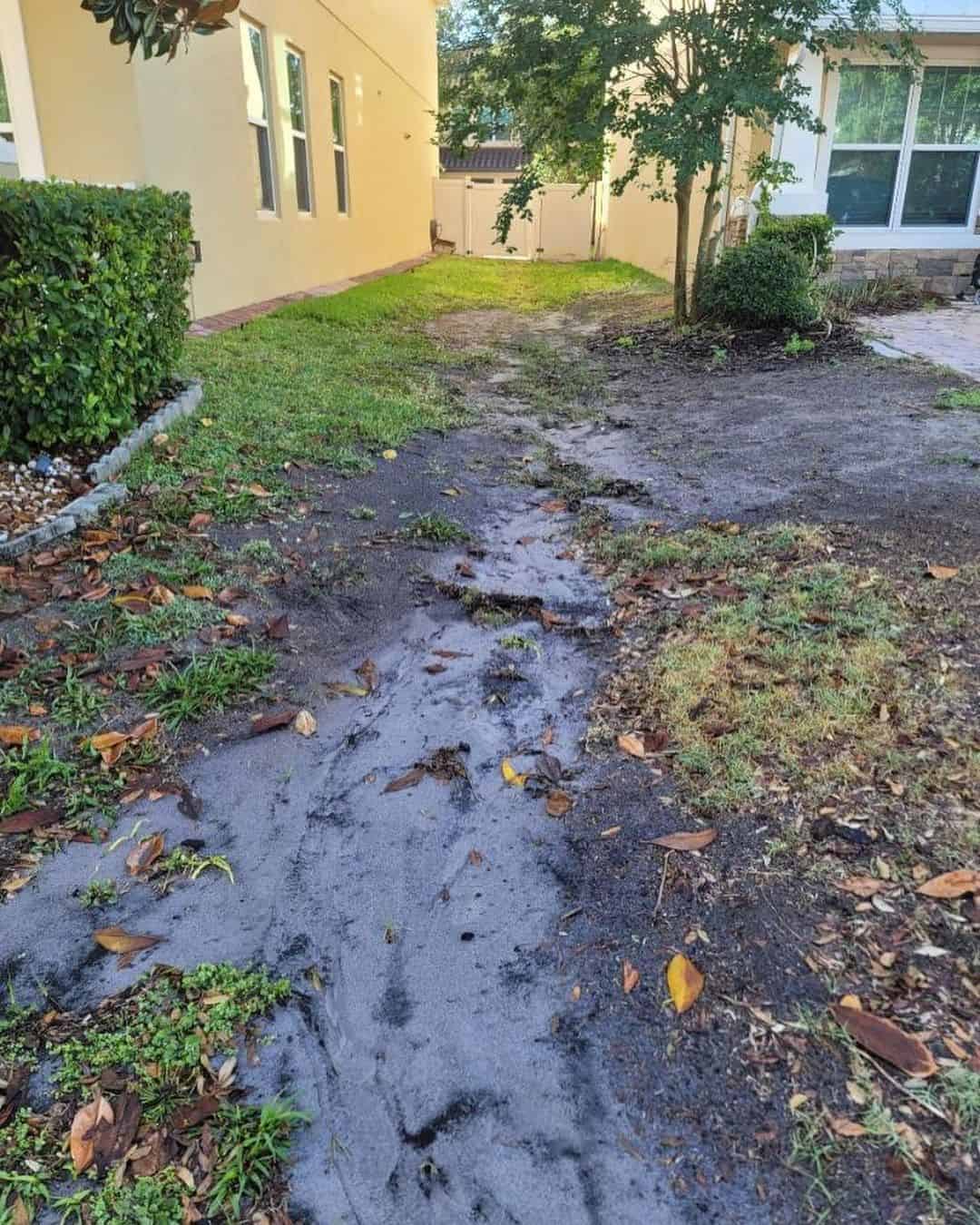Water Runoff from Next Door onto My Property (What Can I Do?)

Are you dealing with water runoff from your neighbor’s property? Do you want to know the steps you can take to address the problem?
Water runoff from a neighboring property can spark feuds between you and your neighbor. Whether caused by flood, surface runoff, or leaking drainage, the runoff water can cause significant damage to your garden, foundations, and lawns.
Luckily, you can take several steps to address and tackle the problem, including seeking legal action. In this guide, we will discuss some effective ways to resolve water runoff issues.
Besides that, you will discover several tips to help you shield your property from water damage in the future.
What Do I Do If A Neighbor Drains Water Onto My Property?
What Does the Law Say About Water Runoff?
Most jurisdictions have varying laws regarding surface water runoff and flooding. However, there are a few principles that all the states share, including:
1. Reasonable Use Rule
The reasonable use rule states that an individual may use a reasonable amount of water from a natural source. But this right must be balanced based on the needs and rights of others.
In the context of surface water runoff or flooding, this legal principle might apply if your neighbor alters his (or her) land. By doing so, causing water damage to your property. In such a case, the neighbor is liable for the inconvenience and damage caused by the runoff.
In most cases, the courts determine what is reasonable. For instance, some courts might find downspouts or gutters that direct rainwater into a neighboring property unreasonable.
If you take legal action against your neighbor over the damage, the court will look at several factors to determine if the neighbor is at fault. They include:
- The nature and significance of improvements
- Whether the damage to your property was foreseeable by the neighbor making the alteration
- The severity of damage compared to the value of the modification
2. Common Enemy Rule
The common enemy doctrine states that surface water is a common enemy to every landowner. Therefore, every individual should fight surface water in a way they see fit, even at the expense of the neighboring property.
Fortunately, most states that follow this rule, like New York and Montana, have revised this doctrine. According to these jurisdictions, an individual can direct surface water to another landowner’s property if the work is necessary and only if they use reasonable care to prevent damage to bordering land.
3. Civil Law Rule
Also known as the natural flow rule, the civil law rule states that a landowner will be held accountable if he alters the natural flow of water, causing harm to the adjoining properties.
Some states have modified this legal principle to allow modification to the property, as long as they are reasonable. Under the revised law, any homeowner who observes increased harm to their property should take the necessary actions to protect their property from water damage.
Remember, laws about water runoff tend to be complex and usually vary depending on the state and specific circumstances of the case.
Before taking legal action against your neighbor, check if your municipality has any laws regarding water runoff. Also, consult a lawyer to understand your rights and options.
Problems Caused by Water Runoff

1. Structural Damage
When excess water flows into your property from into your land from a neighboring property, it can lead to structural damage. The runoff can crack, erode, and destroy several structures over time, including:
- Basements
- Fences
- Foundation
- Garage floor
- Walkway and Driveway
2. Damaged Landscaping
If you don’t get rid of the water immediately, the water can leave your landscape damaged. Too much water causes soil erosion, eventually preventing grass, trees, and flowers from growing.
Besides, the soil might become compact, preventing moisture from penetrating between the soil layers and getting to the plant roots that require it. Compacted soil also means that runoff can’t drain.
3. Drowned Plants
Too much water can drown the trees, shrubs, and grass on your lawn. This can be disappointing and heartbreaking, especially if you spend most of your time tending to the plants. If you don’t want your efforts to waste, drain your garden or yard anytime it floods.
4. Soil Erosion
Perhaps the biggest problem caused by water runoff is soil erosion. Did you know the natural formation of an inch of topsoil takes approximately 100 years?
Surprisingly, it takes only a few milliseconds for unchallenged water to destroy top soils. The water carries away the nutrients and microorganisms on the layer, rendering the soil infertile. It also destabilizes slopes and embankments on your property.
5. Pesticide and Herbicide Pollution
The runoff can carry pesticides, fertilizers, and other contaminants from neighboring properties and dump it on your yard. These pollutants can kill your grass, flowers, and trees.
6. Flooding

If your private property is in a low-lying area or has drainage problems, the excess water can cause flooding. This can damage infrastructure and contribute to the growth of mold and mildew.
7. Dirt and Debris
A heavy flow of surface water can carry dirt, leave debris, mulch, and other sediments from your neighbor’s land and deposit them on your yard. The accumulated material can make a mess of your lawn and even kill your plants.
8. Slippery Surfaces
Sometimes, runoff can flood your driveway and walkways, making them slippery, especially if the water contains oils. When you step on such a surface, you might slip and fall to the ground. Remember, falls can cause severe injuries and even death.
9. Pest Breeding Site
Pests such as mosquitos can breed in standing water. As such, the water flowing from your neighbor’s land can provide such insects the best environment for breeding. This may lead to large swarms of insects that can expose your family to a range of illnesses like malaria, dengue fever, and others.
How To Prevent Water Runoff Damage?
1. Berms
One of the best ways to divert water runoff from your property is by building berms. A berm is a landscape feature that looks like a small hill or mound of earth. They’re mostly found alongside a road or highways.
You can build berms along a flood path to prevent blocking and direct water flow to where you want it. This way, you can prevent your property from water damage. Berms can also add beauty to your home when you use them as a hedge or raised garden. So, they have both functional and decorative roles.
2. Swales
Like berms, a swale can encourage drainage and prevent water from flowing into your land from a neighbor’s yard.
It is a shallow channel or a ditch dug on a counter to convey water and slow down fast-flowing water while directing it to where can be distributed gently. Additionally, it increases the drainage of standing water after heavy storms.
If your lawn has a slope or you live on a hillside, Swales provide you with an effective way of intercepting and diverting surface water. What’s better, you can use berms to direct the water into the swale. You can also plant thirsty plants in the swale to get rid of the runoff faster.
3. Dry Well

A property owner can also control water runoff by installing a dry well. This structure temporarily stores water and then releases the excess slowly.
A dry well is a pit filled with gravel and other porous material to allow surface water to seep in and reduce sediment buildup. It comes in areas that cannot support the installation of traditional drainage systems like French drains and drainage ditches.
Water flows into the well, and it gets absorbed by the porous material. Once it’s full, water flows into the ground. However, if your property sits on top of clay soil, you might have to install a drain pipe below the well to direct water to another place where its readily absorbed.
4. Trench
A trench offers the simplest and most affordable way to divert water trickling from your neighbor’s land. The water will flow inside the trench instead of your lawn and get re-directed to a storm drain.
While trenches prevent water damage, they don’t help to prevent soil erosion, unless you reinforce them with concrete.
5. French Drains
A French drain or curtain drain offers you a controlled way of managing water runoff. Generally, it comprises a perforated pipe enclosed by a layer of gravel and other porous material and is installed in a trench.
The trench is usually lined with fabric to allow water to flow into the pipe free from sediments and flow to discharge points, like the city waterway or storm drain.
French drain prevents groundwater buildup and protects expensive infrastructure from damage.
Does Insurance Cover Runoff Damage
Both homeowner’s insurance and flood insurance may cover your property damaged by water runoff. If the water on your lawn comes from a source within your neighbor’s home, home insurance can come in handy.
Contact your insurance company to pay for the damage. What’s more, you can collect damages from your neighbor’s insurer.
However, if the water runoff originates from rising water, you might need flood insurance. That holds even if your next-door neighbor is at fault.
Conclusion
Before taking any legal action against your neighbor, first, confirm if the water runoff is their fault. If it’s not, follow these steps to protect your property and reduce the risk of damage.
Nevertheless, if the water damage to your home is serious, consider calling an expert to assess your situation and determine a solution.
Hopefully, you have found this information helpful. Let us know in the comment section if you have questions or require further clarification.









